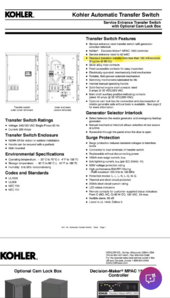Except that, in general, that is how they work. It shift its own production to synchronize with the grid (or generator), and then connect. I suppose a bad inverter can do a hard switchover. But one that is grid enabled has to be able to synch to the grid.
I was specifically referring to the Sol-Ark "catching" the transfer... that would depend on how slow the transfer is. I would assume the Sol-Ark would catch it, but it's not a guarantee.
Yes there is, or the settings wouldn't work. You don't tell by frequency, voltage, wave form, directly. There are dirty grids and ckean generators. Although grids tend to have very stable frequency, but a good generator can too.
No, that's not true. The operation of the Sol-Ark auto start is like this:
no grid available/operating on battery > grid start trigger met by low battery volts/SOC > close gen relay > charge volts and amps met (or TOU target met) > open gen start relay.
There is no "check if AC source on grid input is grid or gen".... in fact even when using gen terminals (120/240v configuration) and auto start relay, the gen keeps running until parameters are met! Even if grid comes back on, and the Sol-Ark transfers back to grid, but gen is still putting 120/240VAC to gen terminals! This happened for one of our customers!
Not hard to wire the SA's gen start line through the ATS gen start line. When the ATS switches back to grid, it opens the circuit.
Yep. I call that a workaround! The first time I did that type of configuration was 10+ years ago, and it sure wasn't because an inverter's "gen" port didn't work right....
Why do we need to create "fixes" that are workarounds?
If you want to charge batteries with the generator, it has to be able to supply more than load. Impossible to charge if there is no excess.
What better inverters can do: 5kw generator. Load goes above 5kw, and inverter supplements (6000xp can't). Load drops below 5kw, and inverter uses excess to charge batteries. What that allows you to do is run a 5kw generator for 6 hours to provide for your 30kwh daily use.
If the inverter can't supplement, then when load goes above 5kw, then inverter has to disconnect generator and run off battery. Now you don't know how long you have to run to recharge because you don't know how long you have been on generator. The only way you know for sure is to get a bigger (10 kw?)
Let me give you a real world scenario. (Not an actual job, but a typical scenario for us.)
Inverter is sized to loads, peak loads are ~10kW. Sol-Ark 15K fits the bill.
Battery storage: 40kW
Auto start gen: Kohler 14RESA (12kW on nat. gas)
In grid down scenario plus low battery the gen starts and loads are average ~4kW. What do you suggest would be a good way to avoid overloading the gen? Set battery charge to max of 2kW to stay under 12kW gen rating? (10kW peak loads + 2kW charge = 12kW)
Or how about this... how about Sol-Ark changes their hardware to support gen shave. Now we could set gen shave to 10kW to stay under the gen's rating, 95% of the time the gen runs it's pushing (10kW - average 4kW load) ~6kW to the batteries. Thsi setup works absolutely perfectly with Schneider, Outback, Magnum, Victron, Midnite Rosie inverters and probably many others.
Why does everyone dance around manufacturers that drop perfect features that have been available for many years now? I'll comment on these for of posts any time I can in order to try to get Sol-Ark's attention!
@Carlos_Sol-Ark are you listening? I love the Sol-Ark inverters.... for the most part... but you guys lack some critical features. If you want to be the best, then be the best. And please listen to the people that work with hundreds of inverters! We already have hundreds of Sol-Arks installed! But if someone else comes with the missing features that you guys don't have, you will lose us just like that! I know we are only one fish in the ocean, but those little details (though I feel this is a big one) are the difference between the men and the boys!






